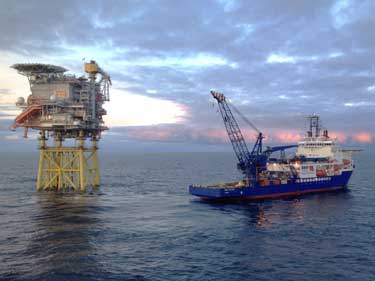 Some 20% of the remaining UK oil reserves are expected to be West of Shetland, a challenging environment on the surface and subsea.
Some 20% of the remaining UK oil reserves are expected to be West of Shetland, a challenging environment on the surface and subsea.
In February 2013, Bibby Offshore was awarded a contract by Premier Oil to provide subsea support during the installation phase of its Solan field development project, in Block 205/26a of the UK Continental Shelf, in 135m water depth.
The facility at the Solan field has been designed to produce a flow rate of 28,000 b/d, peaking at up to 35,000 b/d across a 20-year lifeline.
The production facility has been developed as a not permanently manned installation (NPMI), and will be operated remotely from an onshore control room in Aberdeen. The topsides facility supports produced fluid separation, gas treatment, all necessary utilities and power generation.
The field infrastructure also includes a 10,000-tonne subsea oil storage tank (SOST) capable of storing 300,000 bo. Produced oil is sent to the SOST before being exported, via a single anchor loading system (SAL), to shuttle tankers.
Bibby Offshore was brought in to perform installation of the subsea infrastructure and, recognizing the challenging environment, came up with a plan to minimize downtime caused by short weather windows.
Preparation is Key
To mitigate the impact of this, Bibby Offshore completed detailed weather analysis prior to mobilisation to allow a realistic expectation on the potential downtime that could be experienced. The project team also gathered regular forecasts from various sources to help build an accurate picture in the short term on how the weather would impact over a two to five day window.
Bibby Offshore was also able to take a flexible multi vessel approach to the project, making use of several of the vessels in its fleet. The Dive Support Vessel (DSV) Bibby Polaris was used extensively to complete much of the dive works. The DSV Bibby Sapphire and DSV Bibby Topaz and the Construction Support Vessel (CSV) Olympic Ares also made a significant contribution to the project. Further to this the company used short term chartered Remotely Operated Vehicle Support Vessel (ROVSV) and a third party DSV.
This multi vessel approach helped Bibby Offshore tailor the various vessel capabilities to the technical challenges presented by the development and the flexible timeline required to complete the task in line with the clients programme. Crucially, it also helped to prevent any schedule slippages in order to maintain progress towards achieving first oil.
A Phased Approach
The subsea aspect of the project was planned in two phases. Phase one saw the Olympic Ares carry out installation activities for the single anchor loading system (SAL), metrology, lay through spool removal, flexible and umbilical installation and wet storing of fabricated spools, . Phase two consisted of the diving support operations to complete installation, tie in, stability/protection and recommissioning of the flexible, umbilicals, spools and storage tank.
Each phase of the project had its own challenges. Due to adjustments in the schedule, Bibby Offshore successfully change managed the scheduled fleet workloads to accommodate its client’s requirements, resulting in the project becoming multi phased with, as mentioned previously, additional vessel support.
During the campaign, a 72” structure pile was installed which required a large ninety ton ‘Fast Frame’ to be deployed to the seabed. The loading hose itself presented a range of engineering considerations to the project team due to the inflexibility of the product and the fact it could not be pre-installed on a deployment reel onshore prior to installation on this occasion.
After completing the acoustic metrology, the Bibby Polaris was deployed to connect the pipeline to the SAL spool and the SAL to the offloading hose.
During the offshore operations, the project team configured an optimised deck layout on the Olympic Ares, thus creating the required working space. This was necessary due to a multi reel drive system taking up a significant amount of deck space and also the additional equipment required to install flexible and umbilical products before completing metrology between the newly installed platform and subsea oil storage tank. In subsequent campaigns, two DSVs and one ROVSV were mobilised to carry out spool installations, flexible and umbilical tie-ins, mattressing and general storage tank works.
Bibby Offshore’s track record meant it was ideally positioned to execute the work. However, this particular project posed a number of environmental and installation challenges that allowed the
Key facts

